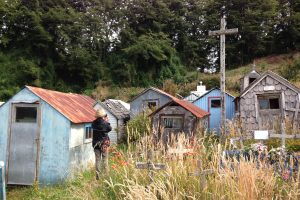Overview
The Urban planner is an agent of the government who arrives at Texaco to assess it for urban renewal/utter destruction, and is hit by a rock. Inhabitants of the town do not take kindly to his arrival. “When the town planner first arrives in Texaco, he is initially perceived as a danger” (Maisier 40). Throughout the story, however, he learns Texaco’s history from Marie-Sophie. As a result, he has a large change of heart by the end of the book. After Marie- Sophie finishes telling him about the history of Texaco, he inspects the town and leaves for many months. However, during this period, things change for the better, and upon his return, he brings electricity and the Good News: “That’s why the Scourge seemed less threatening and why we began to call him Christ, without giving it much thought, and hoped that he would come back… when he reappeared one day and made for my hutch, I knew he was bringing me the latest news: City from now on was taking us under its wing… he told me that City would integrate Texaco’s soul” (Chamoiseau 381).
Real World Connections
Although the Urban Planner is a fictional character, he is representative of a very real role- particularly as an agent of oppression. Historically, urban renewal has been associated with civil rights issues. The Urban Planner of the novel is there to destroy the low income community that is Texaco. When placed in this light it’s easy to understand the hostility of those in Texaco upon the Urban Planner’s arrival. It’s even easier to justify this hostility when context is considered.
Although urban planning is often undertaken under the guise of communal benefit, to improve and create, something must be destroyed. An easily accessible example of this in modern times is the process of gentrification: lower income communities are bulldozed all for the profit of apparently better cleaner communities; a particularly relevant example is Robert Moses’ redevelopment of large sections of New York City and New York State in the 1930s and the 1970s.

Although urban planners have been a tool of an oppressive reality for large swaths of history, with social reform and more economic support, they can often redeem themselves, resulting in the growth of more culturally diverse communities: “On a sunny day in mid-November 2018 the mayor of Castro, the capital city of the Chiloé Archipelago in southern Chile, visited Quehui Island to inaugurate a municipal building. After years of waiting, unfulfilled promises, and several disappointments, the construction of one of the projects most coveted by the islanders was finally concluded… A future without depending entirely on water-mobility infrastructure such as ferries and motorboats to access municipal services became more and more possible every day. The dream of what I address as an ‘anchored state’ (as opposed to a state that depends on water-mobility infrastructure) was coming true” (Rumé 27).
Globalization Connections
The community of Texaco is the crux of globalization in that it is the centerpiece of past economic growth and the future development. Because of the racism and the systemic oppression, descendants of enslaved people inhabit it, making it into an inhospitable place: “The contrasting image of the City—as the place of power and order—and the organic, insalubrious chaos of Texaco transforms this landscape into a diverse and complex ecosystem that is the cradle of life and survival. Neither fully in the City nor fully rural countryside, Texaco as literal mangrove is the point of convergence of the chaos and coherence of the dynamic process of Caribbean identity formation” (Woolward 67). The Urban Planner of the story is the manifestation of the City in the beginning, but slowly grows to epitomize globalization in his growth along with Texaco-not against it. In this way, the Urban Planner is both a symbol of progress and a personified tale of caution.
Works Cited
Maisier, Véronique. “Patrick Chamoiseau’s Novel Texaco and the Picaresque Genre.” Dalhousie French Studies, vol. 57, 2001, pp. 128–36. Accessed 15 Feb. 2023.
Woolward, Keithley P. “Patrick Chamoiseau’s Texaco or the Ecology of Caribbean Identity.” Journal of West Indian Literature, vol. 24, no. 2, 2016, pp. 63–73. Accessed 15 Feb. 2023.
Rumé, Sam. “The Contradictions of Sustainability: Discourse, Planning and the Tramway in Cuenca, Ecuador.” The Social and Political Life of Latin American Infrastructures, edited by Jonathan Alderman and Geoff Goodwin, University of London Press, 2022, pp. 199–222. Accessed 15 Feb. 2023.
Editorial Collective
Sarah Mueller, Samuel Ledesma, Emily Rosenthal, Evan Rossell

